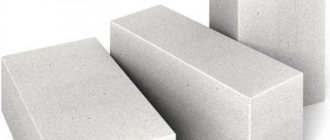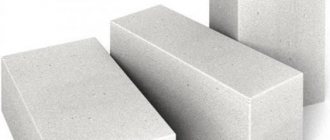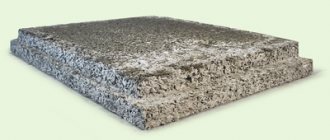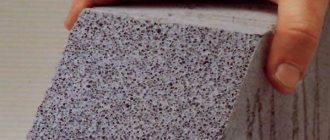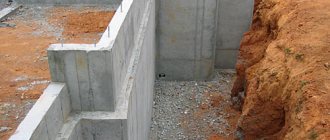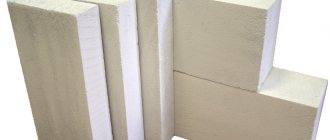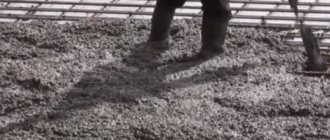Their light weight and good strength, density, and geometry make it possible to speed up the laying process several times.
One of the varieties of such material is expanded clay concrete products with cladding. This stone has a decorative coating on one side, which allows it to be used not only for the construction of walls, but also for decoration.
What are these expanded clay stones?
Expanded clay concrete block with cladding is a modern building material that allows you to construct buildings and other structures with a fine front surface . The use of such raw materials makes it possible to reduce finishing costs several times, but on the other hand, laying with such stone must be perfect, because later you will not be able to hide the flaws.
Expanded clay concrete facing type comes in different types, it can also be painted in different shades, which allows home owners to make a choice. The decorative function of this raw material is maximized, which is why it is well suited for the construction of external walls.
What are they?
Cladding-type expanded clay concrete products are:
- Colored. They look like ordinary expanded clay concrete, only painted in different shades. As you know, the clay from which expanded clay is produced does not have a wide color palette, so more often than not ordinary blocks turn out either gray due to cement, or slightly reddish due to clay.
Therefore, manufacturers can paint the stone a certain color. The blocks can be dark red, green, blue and yellow. They do not require additional finishing, as they are good on their own. - With decorative coating or cladding. Has a slightly different composition. This is a block of expanded clay and cement, but there is decor on the front part of it. It is represented by a unique structure that can imitate wood, natural stone, plaster, and lining. The use of such products allows you to diversify the facade of the house without additional finishing.
- With insulation. These are insulated stones made of expanded clay concrete. The block is taken as the basis, then there is an insulating layer, and then the cladding. High-density polystyrene foam is used as an insulating layer: raw materials of this type are inexpensive. Mineral wool can be found in foreign-made stone as insulation. Sometimes polyurethane foam is used. The density of the foam in the insulating layer ranges from 30 to 70 kg/m³. It is foam plastic with the required thermal conductivity coefficient of 0.036 W/μ, which guarantees a reliably insulated house.
Requirements according to GOST
Features and requirements for expanded clay concrete products with cladding are set out in GOST 6133-99. It says this:
- facing blocks can be solid, slotted or hollow;
- standard block size is 390x190x188 mm, but deviations from the norm of 3-4 mm are allowed on each side;
- facing stone is intended for laying walls without subsequent finishing;
- the strength grade must be at least M50;
- The front block can have either one or two facing faces.
When choosing a facing stone for wall construction, you should be guided by the GOST document.
Product sizes
The blocks for thermal insulation of your building and decorative finishing of the facade are standardized and have the following dimensions:
- Length 40 cm.
- Width 25–40 cm (the most popular products are 30 cm wide).
- Height 20 cm.
The products do not differ in increased dimensions, which makes installation easier. The composite does not create increased forces on the base of the building. Laying is carried out in the same way as installing bricks.
Laying a wall from multilayer building blocks
What types of walls are they used for?
Clad blocks made of expanded clay and concrete are used for the construction of :
- external facade walls of the house;
- baths;
- cottages;
- summer houses;
- country houses;
- gazebos;
- buildings for economic purposes.
With the help of such building material, you can not only build walls, but also simply veneer them. Expanded clay concrete block with decor is perfect for cladding wood-frame houses. However, this building material is not used for the construction of internal walls of the room, as well as for plinths.
The basis
The thickest part of the heat block is the load-bearing part. It is usually based on expanded clay concrete, polystyrene concrete and other types of lightweight concrete. The main filler in lightweight concrete is porous materials with small cells and voids. This feature of the filler allows the production of a load-bearing part with different density and volumetric mass options. This is an advantageous building material with reduced material consumption and significantly reduces the cost of the finished block.
In addition, the low density ensures low weight of the finished blocks. These factors greatly facilitate the process of transportation, laying walls and increase the speed of construction of the finished building.
Walls built from such lightweight blocks are comfortable, safe from an environmental point of view and provide a high level of sound insulation.
Main characteristics of the material
Such stones have several main characteristics:
can be solid, slotted or hollow, depending on this their characteristics change;- strength grade within M50-M150;
- weight – from 12 kg;
- volumetric weight – 700-1500 kg/cub.m;
- frost resistance – 50 cycles of defrosting and freezing;
- thermal conductivity - 0.15-0.45 W/mG;
- wall cooling time – from 75 to 90 hours;
- water absorption – 50%.
Shrinkage is 0%, so this material has become very popular in the construction and cladding of walls.
Separately, it is worth mentioning the size of the block. It comes in sizes 390x190x190 mm, 390x188x188 mm, 390x190x188 mm. The dimensions are similar to the standard sizes of blocks that are used in construction, so this material can be used for the construction of load-bearing walls of a house.
Area of use
Modular composites are widely used in the construction of small buildings where it is important to provide effective thermal insulation, quickly complete the work and achieve savings. At the same time, blocks are in demand for the construction of multi-story buildings. It is not advisable to use them for main walls and load-bearing structures.
Three-layer composites are used for frame construction of a house. The main forces are absorbed by the frame, and a wall of modular elements is erected nearby. Due to the fact that walls made of sandwich blocks have a smaller width than brickwork, the interior space of the room increases with the same external contour.
Features of masonry
It is recommended to use special solutions for laying such blocks . Since there will be no insulation in the future, it is better to use compounds with thermal insulation characteristics. They can also use reinforcing additives.
It is better if the stone is produced with a tongue-and-groove fastening, then the connection of two adjacent expanded clay blocks is simplified.
Since the facade block is the only material and nothing is used after it, it is important to maintain the exact evenness of the masonry . To do this, be sure to pull the string, plumb line, and after laying each stone, check the evenness with a building level. A laser level will provide the greatest accuracy.
At the end of the laying, it is necessary to check all the stones for cleanliness. It is possible that during the work some of the solution got onto the front side, which will spoil the appearance. To eliminate errors, it is better to immediately remove excess glue.
Decorative layer
The final outer layer on the front surface is decorative. The variety of design options for the outside of a multilayer block allows you to decorate walls in various styles, creating your own unique compositions that are in harmony with the overall architectural design. The thickness of this layer usually does not exceed 3 cm.
In addition to a purely aesthetic function, external finishing allows you to protect the inner layer from mechanical damage, thereby significantly increasing the service life of the entire building. The front side can be multi-colored or textured, and also imitate noble natural materials - such as granite, marble and others.
Pros and cons of use
There are several main advantages of using such a stone:
- installation speed increases;
- no need for finishing;
- work is done easily;
- good thermal insulation performance can be achieved;
- construction costs are reduced;
- the blocks are fire-resistant, environmentally friendly and durable.
One of the disadvantages is the thoroughness of the work, since you need to lay the stone immediately “for finishing”. Also one of the disadvantages is the need for constant maintenance of the cladding.
Advantages
Thanks to its “multi-layering”, any multiblock has a number of advantages over any traditional building materials. Firstly, strength. All layers of the multiblock are bonded together not only with binding solutions, but also with strong reinforcing bars. This ensures high strength and durability of the multilayer structure.
Secondly, ease. It was already noted above that due to the special composition of the load-bearing part, the multilayer block has much less weight compared to traditional materials. Accordingly, their dimensions will be small. A modern building, built from multilayer blocks, has a thickness of external walls of about 3-3.5 cm. Therefore, there is no need to dig a deep and reinforced foundation for such a structure.
Thirdly, thermal insulation. Modern heat-retaining materials allow the structure to have high insulation characteristics. For comparison, the thickness of conventional insulation laid on the finished walls of a house will be at least 2-4 cm. The thickness of the entire wall, made of multilayer building blocks, will be only about 3.5 cm. And in such a room it will be as warm and comfortable as and in standard insulated buildings.
Moisture insulation and resistance
Modern thermal insulation materials are sensitive to the ingress of steam and moisture. Constant contact with a damp environment gradually destroys the insulating layer and reduces its characteristics. In multiblocks, the layer is reliably protected by cladding. The outer layer is designed in such a way that the thermal insulation retains its properties for many years.
They are also characterized by resistance to corrosion, fungi and mold. The “three in one” design consists of chemically inert substances that weakly interact with the aggressive environment.
In addition, the special properties of the starting materials that make up the building block make the environment inside it unsuitable for the proliferation of microorganisms.
Climate and convenience
Buildings constructed using multilayer blocks will last for many years even in the most difficult climatic conditions. Concrete blocks retain their performance characteristics over a wide temperature range, and special technologies for creating the facing layer make it resistant to various mechanical damage.
Using three-layer building blocks, you can significantly speed up the process of building your own home, thereby saving time and money. In addition, a building built from multiblocks will ultimately cost much less than the same structure built from classical building materials with subsequent insulation.
Prices for stones with decoration
As an example of cost, you can consider several options for facing blocks made of expanded clay:
front color full-bodied 390x95x188 mm – 72 rub. per piece, 12,000 per cubic meter;- colored gray 2-hollow double-sided 390x120x188 mm – 42 rub. per piece, 5250 rub. per cube;
- chipped gray solid 380x95x188 mm – 52 rub. per piece, 8600 rubles per 1 cubic meter;
- decorative red, brown 2-hollow 390x190x188 mm – 77 rub. per piece, 5900 rub. per cubic meter.
As you can see, average prices will differ depending on the type of stone - slotted, hollow or solid, its color and texture.
Reinforcement
Reinforcement of blocks can be done using reinforcing mesh, filling it with masonry glue. Every third or fourth row of masonry can be reinforced. Internal partitions are connected to load-bearing walls using grooves, which can be made with a chisel, wall cutter or hammer drill. Sometimes fiberglass or steel embedded elements are used. The base of the insulated block is easily processed with dowels or standard nails. For expected heavy loads, injection dowels can be used.
The cost of a house built from insulated “three in one” building materials can be compared with popular houses built using Canadian technologies. Only a house made from thermal blocks is much more environmentally friendly and durable, and in terms of its operational characteristics it can belong to the premium class of capital buildings.
Wallpaper coverings
Standard paper wallpaper has been replaced by more durable and beautiful materials:
- non-woven; cork; vinyl; liquid wallpaper; textile.
This type of finishing work is implemented after preliminary surface preparation. The craftsman can carefully plaster the surface or cover the wall with plasterboard.
Expanded clay concrete can withstand a galvanized steel profile or guide beam well. The design of a cottage can be implemented in any style. The most popular are house designs made in accordance with the requirements of modern and classic design. In country houses, the “country” or “Provence” style looks especially organic. But, according to the reviews of the owners of houses made of expanded clay concrete, any design project can be easily implemented indoors. The features of a house made of expanded clay concrete blocks are described in the video:
Texture of expanded clay concrete blocks
The products differ not only in their internal structure, but also in their external design. There are different types of surface:
- Smooth, without processing.
- Polished.
- Corrugated with geometric depressions and bulges.
- Prickly.
- With lining.
Color variety
Expanded clay concrete blocks can be of a standard shade or colored. Coloring is carried out at the stage of manufacturing the building mixture. Pigments of the desired color are introduced into it. Therefore, it turns out uniform and neat and does not require additional coloring. They can be used as facade and cladding.
Multilayer materials
A separate category of ready-made piece materials is three-layer expanded clay concrete blocks with insulation and cladding, which have appeared recently. Polystyrene and a textured finishing layer are applied on top of the expanded clay concrete. They do not require additional insulation and retain heat well.
Expanded clay concrete blocks with cladding in Moscow
Facing expanded clay concrete block 500x300x188 mm
Buy a facing hollow expanded clay concrete block measuring 500x300x188 mm in Moscow at a price of 2,763 rubles. per cubic meter you can in our online store..
Facing expanded clay concrete block 390x190x188 mm
Buy a facing hollow expanded clay concrete block measuring 390x190x188 mm in Moscow at a price of RUB 2,672.1. per cubic meter you can in our online store..
Facing expanded clay concrete block 300x200x400 mm
Buy a facing hollow expanded clay concrete block measuring 300x200x400 mm in Moscow at a price of 2069.6 rubles. per cubic meter you can in our online store..
Facing expanded clay concrete block 200x200x400 mm
Buy a facing hollow expanded clay concrete block measuring 200x200x400 mm in Moscow at a price of RUB 3,284.7. per cubic meter you can in our online store..
Facing expanded clay concrete block 200x200x400 mm
Buy a facing hollow expanded clay concrete block measuring 200x200x400 mm in Moscow at a price of RUB 2,550.9. per cubic meter you can in our online store..
Facing expanded clay concrete block 400x400x200 mm
Buy a facing hollow expanded clay concrete block measuring 400x400x200 mm in Moscow at a price of RUB 2,537.4. per cubic meter you can in our online store..
You can buy expanded clay concrete blocks with cladding in Moscow at a price of 320 rubles per piece.
Wall blocks made of expanded clay concrete represent an optimal balance of strength characteristics and thermal insulation qualities. Thanks to its convenient dimensions, several times larger than standard ceramic bricks, construction using expanded clay concrete products proceeds quickly.
Almost the only drawback of conventional wall blocks is their nondescript appearance; constructed buildings require façade cladding. The solution to this problem was cladding modules made of expanded clay concrete, thanks to which it is possible to combine the construction of external walls with their finishing. They produce both front products with one decorative edge and corner ones with two.

